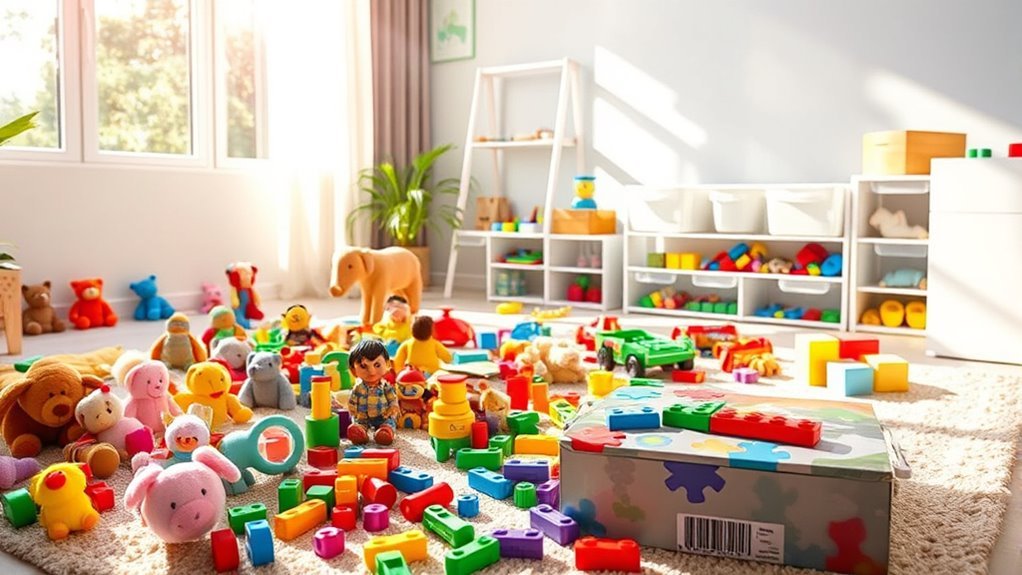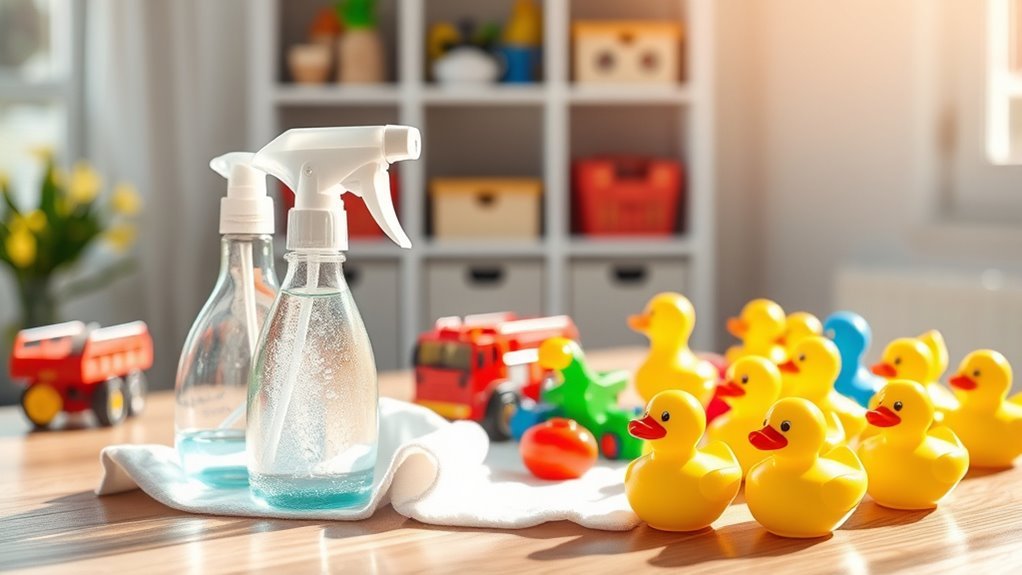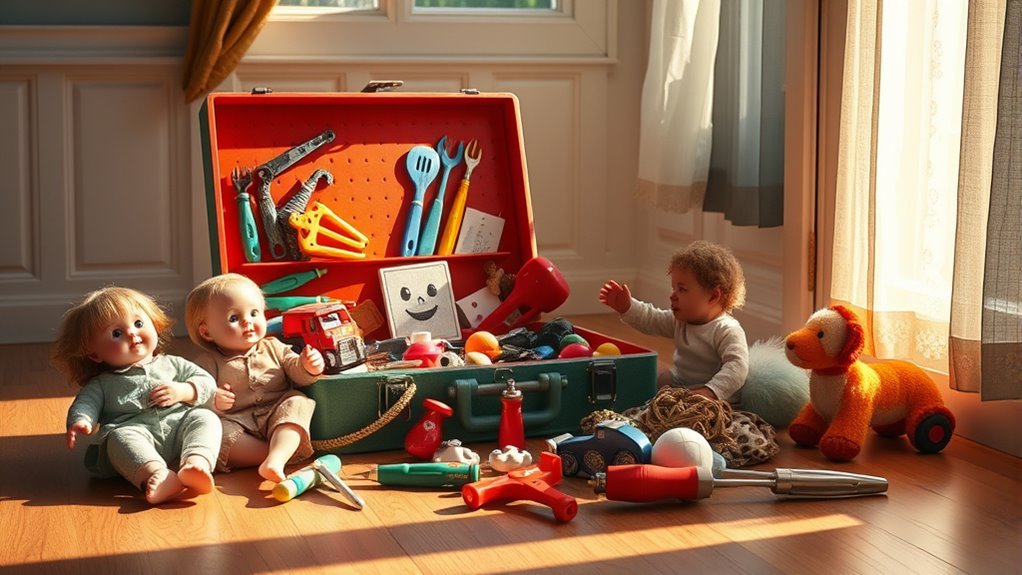Spring Cleaning Guide for Toys
For a successful spring cleaning of toys, start by sorting them by type and checking for any safety hazards like broken parts or choking risks. Clean plush toys gently with mild detergent, and disinfect plastic toys using safe solutions like diluted vinegar. Organize small pieces in labeled bins, repair any damaged toys, and plan donations for those no longer needed. Involving kids can make the process fun and teach responsibility. Keep going to discover tips on storage and making cleanup enjoyable.
Sorting Toys by Type and Condition

Before you plunge into cleaning, gather all the toys and sort them by type and condition. This step is essential for freeing up space and making your spring cleaning efficient. Use simple toy classification methods—group similar items like puzzles, dolls, and building blocks together. Assess each toy’s condition: keep what’s safe and intact, set aside broken pieces for repair or disposal, and consider donating toys that no longer spark joy. Incorporating a seasonal toy rotation helps maintain a clutter-free environment by storing off-season toys away, leaving only current favorites in reach. This approach not only streamlines your space but also renews your child’s excitement when toys reappear throughout the year. Sorting thoughtfully gives you control and creates freedom in your home.
Checking for Safety Hazards
As you clean, check each toy for broken parts that could cause injury. Be sure to remove any small pieces that might pose choking hazards. Also, confirm the materials are non-toxic to keep playtime safe.
Inspect for Broken Parts
One essential step in your toy spring cleaning is inspecting each item for broken parts that could pose safety hazards. You want your kids to enjoy their toys without worry, so taking time to spot cracks, loose pieces, or sharp edges is vital. Using toy maintenance tips can help you identify what needs repair or replacement. Keep toy repair essentials on hand to fix minor issues quickly, ensuring safety and freedom to play.
| Broken Part | Risk Level | Action Needed |
|---|---|---|
| Cracked toy | High | Repair or discard |
| Loose parts | Medium | Tighten or fix |
| Sharp edges | High | Sand or cover edges |
Stay vigilant—your attention keeps playtime safe and fun!
Remove Small Choking Hazards
Many small toy parts can become choking hazards, especially for younger children, so you need to carefully check and remove any pieces that are small enough to fit in a child’s mouth. Start by sorting through toys and identifying any loose buttons, beads, or detachable parts. Use choking hazard identification guidelines to determine which pieces pose risks. This process is crucial for toy safety education, empowering you to create a safe play environment without restricting a child’s freedom to explore. Remember, even toys labeled as safe can have small components that break off over time. Removing these hazards guarantees you’re not just cleaning but actively protecting your child’s well-being. Stay vigilant, and make this a routine part of your spring cleaning to keep playtime safe and worry-free.
Ensure Non-Toxic Materials
Ensuring that toys are made from non-toxic materials is essential for your child’s health and safety. When you’re sorting through toys this spring, focus on those made with eco friendly materials that minimize harmful chemicals. Prioritize toy safety by checking labels and certifications. Here are key steps to keep in mind:
- Look for toys labeled BPA-free, phthalate-free, and lead-free
- Choose products made from natural or recycled materials
- Avoid toys with strong chemical smells or peeling paint
- Verify certifications like ASTM, CPSIA, or EN71 for safety compliance
- Opt for brands committed to sustainable and non-toxic production
Cleaning Plush Toys Effectively
Although plush toys can be delicate, you can clean them effectively without causing damage. Start by checking the care label for fabric care instructions—some plush toys are machine washable, while others need gentle handwashing. For plush washing, use a mild detergent and cold water to protect the fabric’s integrity. If you opt for machine washing, place the toy in a mesh laundry bag to avoid distortion. After washing, air dry your plush toy completely; avoid heat, which can harm the fabric and stuffing. Spot cleaning with a damp cloth and mild soap works well for small stains, giving you freedom to refresh toys quickly. By following these simple steps, you’ll keep your plush toys clean and soft while preserving their shape and charm.
Disinfecting Plastic and Hard Toys

When disinfecting plastic and hard toys, you’ll want to choose cleaning solutions that are both effective and safe. Using simple mixtures like diluted bleach or vinegar can sanitize without damaging the toys. Let’s explore the best techniques to keep those toys germ-free and kid-safe.
Effective Cleaning Solutions
Since plastic and hard toys can harbor germs, you’ll want to use cleaning solutions that effectively disinfect without damaging the material. Choosing eco friendly cleaners or homemade solutions lets you keep toys safe and your space toxin-free. You don’t have to rely on harsh chemicals to get the job done. Here are some effective options:
- Mild dish soap mixed with warm water for gentle cleaning
- White vinegar diluted with water as a natural disinfectant
- Baking soda paste to scrub stubborn grime
- Hydrogen peroxide for deeper disinfecting (test first)
- Commercial eco friendly toy cleaners designed for plastics
These choices give you freedom to clean thoroughly while respecting your family’s health and the environment. Just pick what works best for you and your toys!
Safe Sanitizing Techniques
A variety of safe sanitizing techniques can help you disinfect plastic and hard toys without causing damage. You don’t have to rely on harsh chemicals; instead, choose eco friendly products that protect both your child and the planet. Simple sanitizing methods like a solution of white vinegar and water or gentle soap with warm water effectively kill germs while preserving the toy’s integrity. Avoid soaking electronic or battery-operated toys; instead, wipe them down with disinfectant wipes made from natural ingredients. Always rinse toys thoroughly after sanitizing to remove any residue. By adopting these mindful practices, you maintain a clean play environment without compromising your values or your child’s health, giving you freedom to enjoy playtime worry-free.
Organizing Small Toy Parts and Accessories
Keeping small toy parts and accessories organized can save you a lot of time and frustration. When everything has its place, playtime flows freely without hunting for missing pieces. To keep things simple and stress-free, try these tips:
- Use clear toy bins to separate parts by type or set.
- Implement labeling systems on each bin for quick identification.
- Group tiny items like puzzle pieces or action figure accessories in small containers within larger bins.
- Store frequently used items at eye level for easy access.
- Regularly declutter to keep only what’s needed and loved.
Repairing Broken or Damaged Toys

Three simple tools can often bring broken or damaged toys back to life, saving both money and memories. When you embrace toy repair techniques, you regain control over clutter and keep cherished playthings in action. Using glue, tape, and a screwdriver, you can fix many common issues quickly. Plus, exploring creative upcycling ideas lets you transform broken toys into new treasures, sparking more fun and freedom.
| Damage Type | Repair Method |
|---|---|
| Loose Joints | Tighten screws |
| Cracked Plastic | Use strong adhesive |
| Faded Colors | Apply non-toxic paint |
| Missing Parts | Repurpose pieces |
With these simple steps, you’ll extend your toys’ life and embrace a clutter-free, creative space.
Creating a Toy Donation Plan
Once you’ve repaired what you can, it’s time to decide which toys no longer serve a purpose in your home. Creating a toy donation plan helps you free up space while giving joy to others. Start by researching local donation locations and reputable toy charities that align with your values. Here’s how to make the process smooth:
- Sort toys by condition and age-appropriateness
- Identify nearby donation locations with drop-off hours
- Contact toy charities to confirm what they accept
- Clean and package toys neatly for donation
- Schedule a convenient drop-off or pick-up time
Setting Up a Storage System
A well-organized storage system can make all the difference when it comes to managing your child’s toys. Using storage bins helps you create order without sacrificing freedom to move and play. Combine that with clear labeling systems, and your child can easily find and return toys independently.
Here’s a simple setup to ponder:
| Storage Bin Type | Ideal For | Labeling Tips |
|---|---|---|
| Clear Plastic | Small toys & parts | Use picture labels |
| Fabric Bins | Plush toys | Write names & colors |
| Stackable Boxes | Building blocks | Number or color code |
This system keeps toys accessible yet contained, giving everyone more freedom to enjoy playtime without clutter stress.
Involving Kids in the Cleaning Process
How can you turn toy cleanup into a fun and educational activity? Involving your kids in the cleaning process encourages responsibility while making team cleaning enjoyable. When you frame cleanup as a series of fun activities, your kids will feel more engaged and motivated.
Here are some tips to get everyone involved:
- Turn sorting toys into a game by timing how fast they can organize.
- Use colorful bins and labels to make storage visually appealing.
- Play upbeat music to keep energy high during cleaning.
- Offer small rewards or praise to celebrate teamwork.
- Let kids choose which toys to clean or donate.
Frequently Asked Questions
How Often Should I Deep Clean My Child’s Toys?
You should deep clean your child’s toys at least once a month to keep toy hygiene practices effective and maintain a healthy environment. Of course, if your child frequently shares toys with others or if toys get visibly dirty, you might want to clean them more often. Setting up flexible cleaning schedules lets you balance thoroughness with your lifestyle, giving you freedom while ensuring those toys stay safe and germ-free.
What Cleaning Products Are Safe for Wooden Toys?
When cleaning wooden toys, you’ll want to stick with natural cleaners to keep them safe and in great shape. Avoid harsh chemicals that can damage the wood or leave harmful residues. A simple mix of mild soap and water or a vinegar-water solution works wonders. This approach not only supports toy maintenance but also lets you enjoy the freedom of knowing your child’s toys are clean, safe, and eco-friendly.
Can Electronic Toys Be Cleaned With Water?
You shouldn’t clean electronic toys directly with water because it can cause water damage and compromise electronic safety. Instead, use a damp cloth or disinfectant wipes to gently clean the surface without soaking the toy. This way, you keep the circuits safe and avoid any malfunctions. Remember, protecting your kid’s toys means maintaining their freedom to play without interruptions caused by damaged electronics.
How Do I Prevent Mold on Stored Toys?
To keep your stored toys in the best shape, embrace a little “environmental harmony” by ensuring they’re completely dry before tucking them away. For mold prevention, use airtight containers or breathable fabric bags to control moisture. Adding silica gel packets can also help regulate humidity. Store toys in cool, dry places with good airflow. These storage tips not only protect your toys but also give you freedom from worries about unwanted guests like mold.
What Are Eco-Friendly Options for Toy Disposal?
If you’re looking for eco-friendly options to dispose of toys, consider donation centers first—they give your toys a second life while helping others. You can also check local recycling programs that accept plastics and metals from toys, ensuring materials don’t end up in landfills. By choosing these routes, you free yourself from waste guilt and promote sustainability. It’s a simple way to keep your space clutter-free and eco-conscious at the same time.






